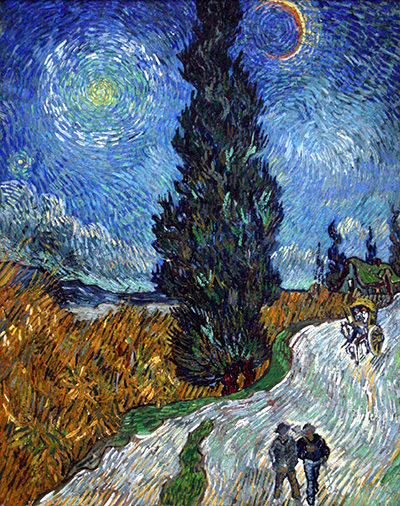One of the themes that appears repeatedly in Vincent van Gogh's artwork is that of the cypress tree.
Toward the latter part of his life, he found a fascination in these trees and brought them from the background of his paintings into being the subject. In 1890 van Gogh painted Road with Cypress and Star as one of his last paintings; in July of that year he died from an infection caused by a self-inflicted gunshot wound. Road with Cypress and Star portrays at its centre a large, dignified cypress tree that separates two sides of the dark night sky. On one side there is a faint star, surrounded by a circle of light; on the other the moon is a thin crescent casting its cool glow on the scene.
A road twists from the side of the painting and leads a cart and two people past the large cypress tree. In the background, a small house sits, possibly with a few more smaller cypress trees surrounding it. The fascination with cypress trees came late in van Gogh's work, though some instances of them can be seen earlier. Van Gogh likened the elegant trees to Egyptian obelisks, and made the conscious decision that they would become a focal point for his creations. An interesting detail is that in multiple instances of van Gogh's use of trees, they extend past the top of the canvas and out of view. That is the case in Road with Cypress and Star, where a large portion of the tree is cut off.
The sky itself is similar to that of the famous painting Starry Night, though the movement and the broad strokes of the many blues is more subtle in this one. It was the last painting that van Gogh did while in Saint Rémy, and it has been suggested that the star and the cypress combined symbolise his awareness of his oncoming death. Whether or not the painting holds these morbid themes, there is no doubt that the colours and the unusual (yet familiar) shapes within it draw the eye no matter where it is seen.




